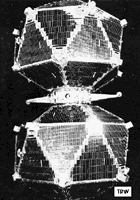Vela
 The Vela (meaning "watchman" in Spanish) series of spacecraft were designed to monitor worldwide compliance with the 1963
nuclear test ban treaty. The satellites were so successful, each operating for at least 5 years, that a planned acquisition of a fourth
and fifth pairs was cancelled. Instead, TRW was awarded afurther contract in March 1965 for an Advanced Vela spacecraftseries. The Vela series was the first spacecraft procurement toutilize a fixed price incentive contract.
The Vela (meaning "watchman" in Spanish) series of spacecraft were designed to monitor worldwide compliance with the 1963
nuclear test ban treaty. The satellites were so successful, each operating for at least 5 years, that a planned acquisition of a fourth
and fifth pairs was cancelled. Instead, TRW was awarded afurther contract in March 1965 for an Advanced Vela spacecraftseries. The Vela series was the first spacecraft procurement toutilize a fixed price incentive contract.
Spacecraft
Spin stabilized at 120 rpm. 20-sided polyhedrons with body mounted solar cells generating 90 W. During launch, 2 satellites were connected by a central cylinder containing an apogee motor.
Payload
Twelve external X-ray detectors and 18 internal neutron and gamma-ray detectors. The third pair (F5, 6) carried an improved detector package, including an optical nuclear flash instrument.
| Country of Origin | United States |
| Customer/User | USAF |
| Manufacturer(s) | TRW |
| Size | 1.4 m diameter |
| Orbit | Average 102000 km, incl. = 38 deg., two spacecraft in the same plane with 180 deg separation |
| Design Life | 6 months |
Launch Facts
| Name | Int'l Desig. | Date | Site | Vehicle | Orbit | Mass(kg) |
| Notes | ||||||
| Vela 1 | 1963-039A | 10/17/63 | ESMC | Atlas Agena D | VHO | 220 |
| Vela 2 | 1963-039C | 10/17/63 | ESMC | Atlas Agena D | VHO | 220 |
| Vela 3 | 1964-040A | 7/17/64 | ESMC | Atlas Agena D | VHO | 220 |
| Vela 4 | 1964-040B | 7/17/64 | ESMC | Atlas Agena D | VHO | 220 |
| Vela 5 | 1965-058A | 7/20/65 | ESMC | Atlas Agena D | VHO | 235 |
| Vela 6 | 1965-058B | 7/20/65 | ESMC | Atlas Agena D | VHO | 235 |
Information in The Mission and Spacecraft Library is provided without warranty or guarantee. USE AT YOUR OWN RISK.